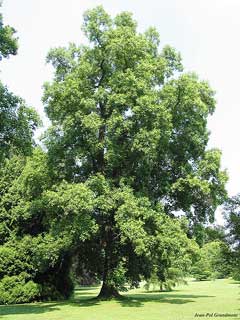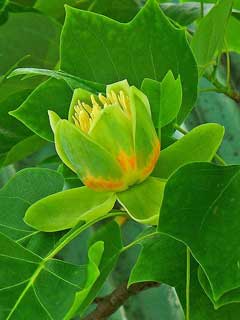 |
|
http://commons.wikimedia.org/wiki/User:Jean-Pol_GRANDMONT |
 |
| http://commons.wikimedia.org/wiki/User:Llez |
Translate this page:
Summary
Bloom Color: Green, Yellow. Main Bloom Time: Early spring, Late spring, Mid spring. Form: Oval, Rounded.
Physical Characteristics

 Liriodendron tulipifera is a deciduous Tree growing to 30 m (98ft) by 12 m (39ft) at a medium rate.
Liriodendron tulipifera is a deciduous Tree growing to 30 m (98ft) by 12 m (39ft) at a medium rate.
See above for USDA hardiness. It is hardy to UK zone 4. It is in flower from June to July, and the seeds ripen in October. The species is hermaphrodite (has both male and female organs) and is pollinated by Beetles.
It is noted for attracting wildlife.
Suitable for: light (sandy), medium (loamy) and heavy (clay) soils. Suitable pH: mildly acid, neutral and basic (mildly alkaline) soils. It cannot grow in the shade. It prefers moist soil.
UK Hardiness Map
US Hardiness Map
Synonyms
Tulipifera liriodendron.
Plant Habitats
Woodland Garden Canopy;
Edible Uses
Edible Parts:
Edible Uses: Condiment
The root is used as a lemon-like flavouring in spruce beer, where it also serves to correct the bitterness of the beer[2]. The bark of the root and branches have a pleasant rather pungent scent[11].
References More on Edible Uses
Medicinal Uses
Plants For A Future can not take any responsibility for any adverse effects from the use of plants. Always seek advice from a professional before using a plant medicinally.
Anthelmintic Aphrodisiac Cardiac Diuretic Dysentery Nervine Poultice Tonic
The intensely acrid bitter inner bark, especially of the roots, is used domestically as a diuretic, tonic and stimulant[82, 213]. The raw green bark is also chewed as an aphrodisiac[222, 257]. The bark contains 'tulipiferine', which is said to exert powerful effects on the heart and nervous system[46, 61, 213]. A tea is used in the treatment of indigestion, dysentery, rheumatism, coughs, fevers etc[222, 257]. Externally, the tea is used as a wash and a poultice on wounds and boils[257]. The root bark and the seeds have both been used to expel worms from the body[213, 257].
References More on Medicinal Uses
The Bookshop: Edible Plant Books
Our Latest books on Perennial Plants For Food Forests and Permaculture Gardens in paperback or digital formats.

Edible Tropical Plants
Food Forest Plants for Hotter Conditions: 250+ Plants For Tropical Food Forests & Permaculture Gardens.
More

Edible Temperate Plants
Plants for Your Food Forest: 500 Plants for Temperate Food Forests & Permaculture Gardens.
More

More Books
PFAF have eight books available in paperback and digital formats. Browse the shop for more information.
Shop Now
Other Uses
Dye Wood
Landscape Uses - Pest tolerant, Aggressive surface roots possible, Pollard, Specimen. A gold-coloured dye is obtained from the bark[106]. Wood - fine-grained, soft, light, easily worked, durable, brittle, not strong but does not split. A valuable timber, it weighs 26lb per cubic foot and is much used for interior finishes, furniture, construction and plywood[11, 46, 61, 171, 229, 235]. Native North Americans used the tree for making canoes[270]. Special Features: North American native, Attracts butterflies, Fragrant flowers, Attractive flowers or blooms. The flowers produce considerable nectar, making this a good bee plant[21, 229]. Cultivated for its wood in Europe50].
Special Uses
Attracts Wildlife
References More on Other Uses
Cultivation details
Requires a deep rich soil[11, 43, 200] and a sheltered but not overshadowed position[1]. Prefers a slightly acid soil[188]. Succeeds in sun or semi-shade[188]. A very ornamental plant[1], it is fast-growing and moderately long-lived in its native range[229]. Flowers are first produced when the tree is about 15 - 20 years old[229]. Liriodendron tulipifera is the state tree of both Indiana and Tennessee[270]. Intolerant of root disturbance, plants are best grown in pots and placed into their final positions as soon as possible. Any transplanting is best done in May[11]. Trees flower best in regions with long hot summers[200]. Plants are particularly susceptible to attacks by rabbits and hares[200].
References Carbon Farming Information and Carbon Sequestration Information
Temperature Converter
Type a value in the Celsius field to convert the value to Fahrenheit:
Fahrenheit:
The PFAF Bookshop
Plants For A Future have a number of books available in paperback and digital form. Book titles include Edible Plants, Edible Perennials, Edible Trees,Edible Shrubs, Woodland Gardening, and Temperate Food Forest Plants. Our new book is Food Forest Plants For Hotter Conditions (Tropical and Sub-Tropical).
Shop Now
Plant Propagation
Seed - best sown as soon as it is ripe in a shady place in a cold frame[80, 113, 200]. Stored seed requires 3 weeks warm then 12 weeks cold stratification[80, 113]. Germination is usually poor, only about 1% of the seed is viable[80]. When they are large enough to handle, prick the seedlings out into individual pots and grow them on in the greenhouse for at least their first winter. Plant them out into their permanent positions in late spring or early summer, after the last expected frosts[78]. Layering in spring. Do not sever from the parent plant for 2 years[200].
Other Names
If available other names are mentioned here
Native Range
NORTHERN AMERICA: Canada (Ontario (southeast)), United States (Connecticut, Indiana, Massachusetts, Michigan (south), New Jersey, New York, Ohio, Pennsylvania, Rhode Island, Vermont, West Virginia, Missouri (southeast), Illinois, Alabama, Arkansas, Delaware, District of Columbia, Florida, Georgia, Kentucky, Louisiana, Maryland, Mississippi, North Carolina, South Carolina, Tennessee, Virginia)
Weed Potential
Right plant wrong place. We are currently updating this section.
Please note that a plant may be invasive in one area but may not in your area so it's worth checking.
Conservation Status
IUCN Red List of Threatened Plants Status :

Growth: S = slow M = medium F = fast. Soil: L = light (sandy) M = medium H = heavy (clay). pH: A = acid N = neutral B = basic (alkaline). Shade: F = full shade S = semi-shade N = no shade. Moisture: D = dry M = Moist We = wet Wa = water.
Now available:
Food Forest Plants for Mediterranean Conditions
350+ Perennial Plants For Mediterranean and Drier Food Forests and Permaculture Gardens.
[Paperback and eBook]
This is the third in Plants For A Future's series of plant guides for food forests tailored to
specific climate zones. Following volumes on temperate and tropical ecosystems, this book focuses
on species suited to Mediterranean conditions—regions with hot, dry summers and cool, wet winters,
often facing the added challenge of climate change.
Read More
Expert comment
Author
L.
Botanical References
11200270
Links / References
For a list of references used on this page please go here
Readers comment
© 2010, Plants For A Future. Plants For A Future is a charitable company limited by guarantee, registered in England and Wales. Charity No. 1057719, Company No. 3204567.